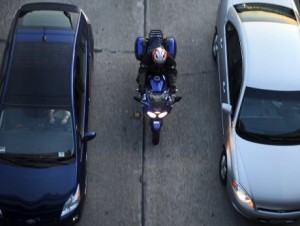If you think Australian road rules vary between states, how about the USA where five states are considering lane-filtering rules each with variances?
Lane filtering (or lane splitting as it’s called in the US) is only legal in California.
However, even there the laws could be about to change with a new bill allowing lane filtering only when traffic is travelling 30mph (48km/h) or less and riders can only filter at 10mph (16km/h) faster than surrounding traffic.
(That’s more generous than in Australia where the maximum speed of lane filtering bikes is 30km/h. That’s just too slow to be able to watch your speedo and traffic at the same time without crashing or breaking the speed limit.)
Oregon has two Senate bills pending which would permit riders to only use the road shoulder where traffic is 25mph (40km/h) or less so long as the rider does not exceed 30mph (49km/h). It doesn’t allow lane filtering between lanes.
In neighbouring Washington, the Senate Transportation Committee recently discussed a bill to allow lane-filtering when traffic is slowed to 25mph (40km/h) or less and riders don’t exceed 10mph (16km/h) more than surrounding traffic.
However, it also includes a provision to fine drivers who impede or prevent a motorcycle from passing. Now that’s something we could do with here!
In Texas, multiple bills would permit the practice when traffic is slowed to 20mph (32km/h) or less on controlled-access highways only. Motorcyclists could not exceed surrounding traffic speeds by more than 5mph (8km/h).
The state is one of the few that allows motorcyclists to rider without a helmet, so long as they are over 21 and have adequate insurance. However, lane-filtering riders will have to wear a helmet under the proposed bills.
Two Tennessee bills would permit lane filtering when traffic is slowed to 45mph (72km/h) or less and riders could not exceed the speed limit.
Lane filtering can be a great way to reduce traffic congestion for all and is certainly a boon to riders’ progress through heavy traffic as well as safer as it avoid rear-enders especially at traffic lights.
However, the varied laws between countries, states and territories makes it a minefield for riders.
So if someone tells you it is legal to lane filter or lane split in their state or country, find out the rules first or you could run foul of the law.
And if you think police radar guns can’t isolate a rider’s speed in heavy traffic, think again!



